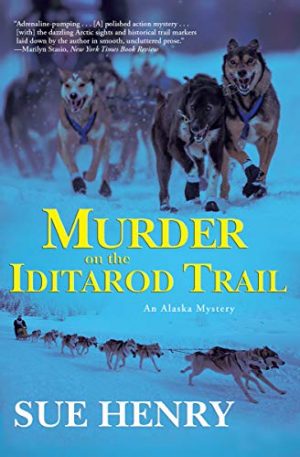
Forecasts in the States are for a snowy winter, and if you want to gear up for the cold, you couldn’t do better than reading Sue Henry’s first Alaska mystery. Whatever the weather throws at the rest of us, compared to people who race the Iditarod, our situation is cosy. This book won Macavity and Anthony awards when it was first published in 1991, and propelled Henry into writing two thriller series based in the 49th state. It has aged well and is worth a new look.
Pretty much all I knew about the Iditarod when I turned the first page is that it is a 1000-mile dog sled race from Anchorage to Nome that you’d have to be near crazy to undertake. Thanks to Henry’s expert weaving of the race’s challenges and perils into the story, I painlessly learned a lot more and am steeped in admiration for the participants. For somewhere between eight and 15 days, they compete through blizzards, white-out conditions, sub-zero temperatures and a brutal wind-chill. The race goes over sea ice, through tricky areas that look frozen solid but may not be, in gale-force winds, and with little time to rest for dogs or humans. The fact that many individual racers continue to compete year after year means… Brrr-r-rrr.
The story begins on a portion of the trail that’s heavily wooded with spruce and alder, when a musher cannot keep awake. The centrifugal force of a sharp turn sends the sleeping man crashing into a tree and the stub of a broken branch enters his skull. Accidents on the trail are inevitable, but death is not. This one was a first and, as it was an unwitnessed death, Alaska State Trooper Sergeant Alex Jensen is called in to investigate. An autopsy back in Anchorage subsequently reveals the dead man’s coffee had been laced with a powerful barbiturate.
To conduct the investigation, Jensen, his young colleague Philip Becker, and their bush pilot Ben Caswell have to keep up with the racers, leapfrogging to the next checkpoint, which all the racers must pass through. Because Jensen is new to Alaska, he doesn’t know a lot about how the race is run or the single-mindedness of the competitors. Over the next week, he’s going to find out.
Henry helpfully starts each chapter listing the date, place, weather, temperature and time. In the early morning of race day three, Jensen begins his inquiries at the Finger Lake Checkpoint, where the high temperature for the day will be a balmy 5˚ F and the low -3˚. There he meets many of the leading mushers and several race officials, people he will encounter repeatedly over the next nine days. He’s happiest to make the acquaintance of musher Jessie Arnold. She’s equally attracted to him, but the race is her top priority.
If that first death unnerved people, a few hours later another disaster occurs. A sled careens off the trail north of Finger Lake and musher Virginia Kline plunges to her death. The gangline on her sled had snapped, and when Jensen arrives, he sees that the line had been cut nearly through. Near the beginning of the race, where these incidents occurred, a long list of people were at the checkpoints when the murdered mushers were also present.
Gradually, as the race teams spread out, the list of people with the opportunity to sabotage their fellow racers shrinks somewhat, but the calamities continue. Different methods are used in every case, suggesting there may be more than one perpetrator at work. Jensen has a personal stake in Jessie Arnold’s safety and urges her to drop out, but she’s determined to continue.
Henry steers the novel’s tension as deftly as an experienced musher traversing Rainy Pass. On the one hand is the fiercely competitive race, with mushers determined to win despite the hazards of weather and terrain and exhaustion. On the other hand is the investigators’ determination to identify the culprit before more deaths and injuries can take place. There’s never any serious consideration of cancelling the race – too much money involved. And the mushers say they’ll go ahead regardless, just without the support of the official checkpoints, warm places to rest, radio communication and hot food.
The Iditarod – the Athabascan name of one of the small villages the race passes through – was never more than of transient interest to me, but Sue Henry brings it to life. In recent years, animal rights groups have objected to the treatment of the dogs, which has resulted in some rules changes. By telling the race’s story so fully, she provides perspective on that issue, as well.
Another thriller featuring the Iditarod is MJ McGrath’s The Boy in the Snow or try one of the many Scandinavian thrillers, like Cecelia Ekbäck’s Wolf Winter.
Grove Press
Print/Kindle/iBook
£7.47
CFL Rating: 5 Stars









